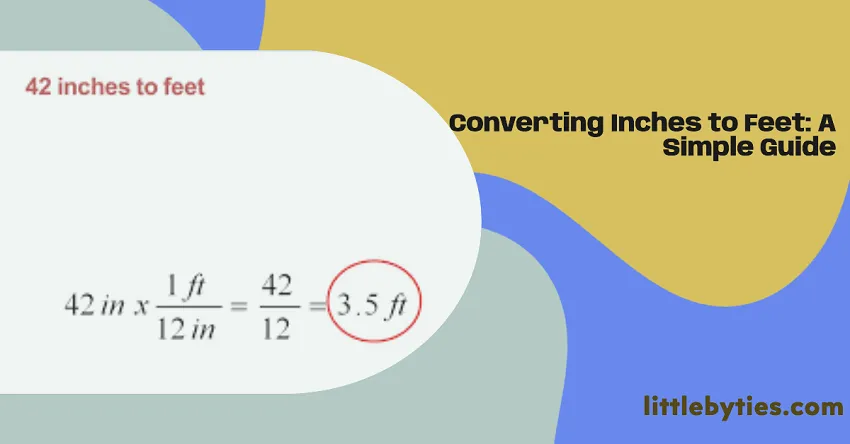Unit conversion is a fundamental skill that plays a crucial role in our daily lives. Imagine you’re redecorating your room and you have a space that’s 42 inches wide. To visualize this space better, you might want to convert those inches into feet. Why? Because feet are often easier to picture in our minds. This conversion is not just about numbers; it’s about making measurements more relatable and practical for everyday use.
Now, let’s focus on converting 42 inches to feet. This specific conversion is more common than you might think. Whether you’re buying a new TV, planning to install new shelves, or even purchasing a rug, knowing how to switch between inches and feet can be incredibly handy. It’s a skill that helps you make better choices and avoid measurement mistakes.
So, how do we convert 42 inches to feet? It’s simpler than it sounds. There are 12 inches in a foot. This means we divide 42 by 12 to find out how many feet it is. This conversion helps you understand measurements in a way that’s easy to visualize and apply. Whether you’re a DIY enthusiast, a student, or just someone trying to figure out if that new sofa will fit in your living room, understanding this conversion can make your life a lot easier.
In this article, we’ll walk you through the process step by step, ensuring you get a clear and easy understanding of how to convert 42 inches into feet.
Basic Concepts of Measurement Units
What is an Inch?
An inch is a small unit of length. It’s like the width of your thumb. Historically, an inch was based on the width of a human thumb. Today, it’s defined more precisely. One inch equals exactly 2.54 centimeters. This standard helps everyone measure things the same way.
The Story of a Foot
A foot is another unit of length. It’s about as long as your foot. Long ago, people used their feet to measure things. That’s how it got its name! Now, a foot is set to be exactly 12 inches. In different places, like the United States and the United Kingdom, a foot is a common way to measure height or distance.
Both inches and feet have been around for a long time. They help us measure things in a way that’s easy to understand. Whether you’re measuring a book, a table, or a room, knowing about inches and feet makes it easier. Let’s keep these simple units in mind as we explore more about measurements
Converting Inches to Feet: A Simple Guide

Converting inches to feet is a handy skill, especially when you’re dealing with everyday measurements. Let’s dive into a step-by-step guide to turn those inches into feet, with some practical examples to see how it works in real life.
Step-by-Step Conversion
- Start with Your Inches: Let’s say you have a number, like 42 inches.
- Remember the Key Ratio: There are 12 inches in a foot.
- Divide the Inches by 12: So, you take your 42 inches and divide it by 12.
- Get the Result in Feet: This division gives you the length in feet.
The Formula Explained
The formula is quite straightforward: Feet = Inches ÷ 12. This is like breaking down a longer stick into shorter, foot-long pieces. It’s a simple division that helps you convert any inch measurement into feet.
Practical Examples in Everyday Life
- Home Decorating: Imagine you’re buying a new sofa. The tag says it’s 42 inches wide. Divide those inches by 12, and you’ll find it’s 3.5 feet wide. Now you can easily figure out if it fits in your living room.
- DIY Projects: Say you’re building a bookshelf that needs to be 42 inches tall. Converting those inches to feet tells you it will be 3.5 feet tall. This helps you visualize the final product better.
- Shopping for Electronics: Consider a TV that’s advertised as 42 inches. Knowing it’s actually 3.5 feet diagonally can help you decide if it’s the right size for your space.
Navigating Advanced Conversion: Decimals, Fractions, and Scientific Notation
When we dive deeper into measurement conversions, things like decimals, fractions, and scientific notation come into play. These might sound a bit technical, but they’re actually quite useful in everyday life. Let’s break them down into simpler terms.
Decimals and Fractions: Making Sense of Measurements
Imagine you’ve converted 42 inches to feet and got 3.5 feet. This decimal, 3.5, is easy to understand but what about when you need it in fractions? In measurements, fractions are often more practical.
Here’s how to interpret it: 0.5 feet means half a foot. Since a foot has 12 inches, half of that is 6 inches. So, 3.5 feet is the same as saying 3 feet and 6 inches. This way of breaking down measurements is super helpful, especially in tasks like woodworking or interior design, where precision is crucial.
Scientific Notation: Simplifying Big Numbers
Scientific notation might seem like it’s for scientists, but it’s also handy for everyday measurements. It’s a way to simplify big or small numbers. For instance, 42 inches can be written as 4.2 x 10¹ inches. When converted to feet, it becomes 3.5 feet, or in scientific terms, 3.5 x 10⁰ feet. This method is especially useful in fields like engineering, where dealing with precise and large measurements is common.
Understanding these advanced concepts in measurement conversion is really useful. It helps you read and use measurements in various formats, whether it’s in decimals, fractions, or scientific notation.
Handy Tools and Apps for Easy Measurement Conversion
In today’s digital world, converting measurements like inches to feet has become easier than ever, thanks to a variety of online tools and mobile apps. Whether you’re a DIY enthusiast, a student, or just someone who needs to make quick conversions, these resources are incredibly helpful. Let’s explore some of the best tools and apps available for measurement conversion.
Online Conversion Tools
- ConvertUnits.com: This website is a go-to for many. It’s simple to use: just type in your measurement (say, 42 inches), select the units you’re converting from and to (inches to feet), and voilà! It gives you the result instantly. It’s free and doesn’t require any downloads.
- Calculator.net: Another great online tool, Calculator.net offers more than just conversion. It provides detailed explanations and formulas. This is especially useful if you’re looking to understand the conversion process better.
- Metric-Conversions.org: This site is user-friendly and efficient. It’s perfect for quick conversions and also offers a bit of background information about different measurement units.
Mobile Apps for Conversion
- Unit Converter (Android & iOS): This app is a favorite for many. It’s not just for inches to feet; it covers a wide range of units. The interface is clean and easy to navigate, making it a handy tool for anyone.
- ConvertPad (Android): ConvertPad is not only a unit converter but also a calculator. It’s ideal for students and professionals who need a more robust tool for various conversions.
- Measure (iOS): This app goes a step further by using augmented reality (AR) for measurements. It’s particularly useful for measuring spaces and objects in real-time.
These tools and apps make measurement conversion a breeze. They’re designed to be user-friendly, accurate, and readily accessible. Whether you’re at home, in a store, or on a construction site, having one of these tools at your fingertips can save time and eliminate guesswork.
Navigating Common Mistakes and Misconceptions in Unit Conversion
When it comes to converting inches to feet, a few common mistakes and misconceptions can lead to confusion. Understanding these can help you avoid errors and make more accurate conversions.

Common Errors in Unit Conversion
- Mixing Up Inches and Feet: A frequent mistake is confusing inches with feet. Remember, 12 inches equal 1 foot. It’s easy to mix these up if you’re in a hurry.
- Rounding Off Too Soon: Another error is rounding off numbers too early in the conversion process. This can lead to inaccurate results. It’s best to do the full calculation first and then round off if needed.
- Forgetting Fractional Parts: Sometimes, people ignore the fractional part after the decimal in a conversion (like 3.5 feet). This half-foot can be significant in measurements, especially in precise tasks like woodworking or interior design.
Misconceptions About Inches and Feet
- “A Foot is Always 12 Inches, No Matter What”: While it’s true that a foot is 12 inches, this can be misleading in real-world applications. For instance, in construction, materials might not always be exactly 12 inches per foot due to manufacturing variances.
- “All Tape Measures are the Same”: Not all tape measures are created equal. Some might have slight differences in markings, especially between different countries or manufacturers. Always double-check for accuracy.
- “Conversion is Complicated”: Many people think converting inches to feet is complex. In reality, it’s a simple division by 12. Understanding this basic principle can make conversions much easier.
Tips to Avoid Mistakes in Unit Conversion
When converting units, especially inches to feet, accuracy is key. Here are some simple tips to help you avoid common mistakes and ensure precise conversions:
- Always Double-Check: After converting, take a moment to recheck your calculations. A quick second look can catch errors you might have missed.
- Use Reliable Tools: For more complex conversions, use trusted online converters or apps. They can do the math for you and reduce the chance of errors.
- Remember the Basics: Keep in mind that 12 inches make a foot. This basic rule is the foundation of converting inches to feet.
- Write It Down: If you’re working on a project, write down your measurements and conversions. Seeing them on paper can help you spot mistakes.
- Practice Regularly: The more you practice converting measurements, the more familiar and accurate you’ll become. Try applying conversions in everyday situations.
- Understand Decimal Points: Pay attention to decimal points in your conversions. They can significantly change the measurement, especially in precise tasks.
- Avoid Rounding Too Early: Wait until the end of your calculation to round off numbers. Rounding too soon can lead to inaccuracies.
Stay Updated: Measurement standards can vary in different contexts. Stay informed about any changes or variations, especially in professional fields.
Ikram Ullah is a seasoned content writer and editor hailing from Faisalabad, Pakistan, boasting a decade of rich experience in SEO and content writing. He is particularly distinguished in the realm of technology content writing, where he excels at demystifying complex technological concepts, making them accessible and engaging for a broad audience. Throughout his career, Ikram has made significant contributions to various websites, showcasing his commitment to technological advancements and his skill in creating informative and compelling content. His portfolio includes work for littlebyties.com, republicansunited.com, and invisiblelocs.net, each reflecting his dedication and expertise in the field.